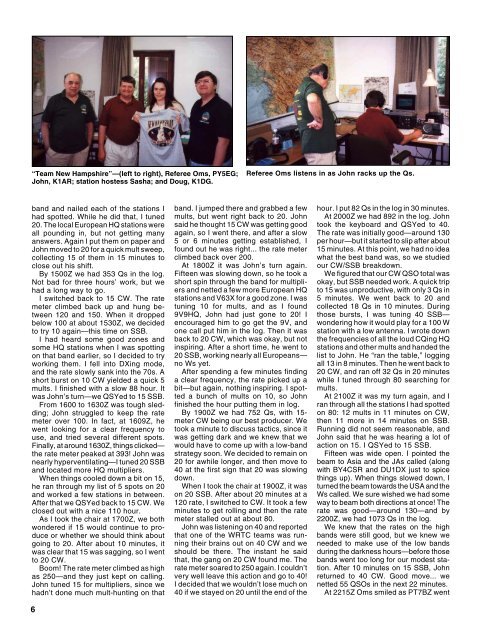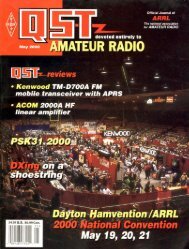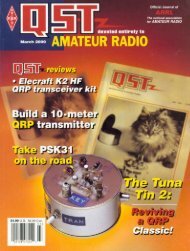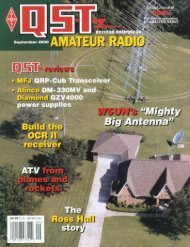September/October 2000 NCJ
September/October 2000 NCJ
September/October 2000 NCJ
Create successful ePaper yourself
Turn your PDF publications into a flip-book with our unique Google optimized e-Paper software.
“Team New Hampshire”—(left to right), Referee Oms, PY5EG;John, K1AR; station hostess Sasha; and Doug, K1DG.Referee Oms listens in as John racks up the Qs.band and nailed each of the stations Ihad spotted. While he did that, I tuned20. The local European HQ stations wereall pounding in, but not getting manyanswers. Again I put them on paper andJohn moved to 20 for a quick mult sweep,collecting 15 of them in 15 minutes toclose out his shift.By 1500Z we had 353 Qs in the log.Not bad for three hours’ work, but wehad a long way to go.I switched back to 15 CW. The ratemeter climbed back up and hung between120 and 150. When it droppedbelow 100 at about 1530Z, we decidedto try 10 again—this time on SSB.I had heard some good zones andsome HQ stations when I was spottingon that band earlier, so I decided to tryworking them. I fell into DXing mode,and the rate slowly sank into the 70s. Ashort burst on 10 CW yielded a quick 5mults. I finished with a slow 88 hour. Itwas John’s turn—we QSYed to 15 SSB.From 1600 to 1630Z was tough sledding;John struggled to keep the ratemeter over 100. In fact, at 1609Z, hewent looking for a clear frequency touse, and tried several different spots.Finally, at around 1630Z, things clicked—the rate meter peaked at 393! John wasnearly hyperventilating—I tuned 20 SSBand located more HQ multipliers.When things cooled down a bit on 15,he ran through my list of 5 spots on 20and worked a few stations in between.After that we QSYed back to 15 CW. Weclosed out with a nice 110 hour.As I took the chair at 1700Z, we bothwondered if 15 would continue to produceor whether we should think aboutgoing to 20. After about 10 minutes, itwas clear that 15 was sagging, so I wentto 20 CW.Boom! The rate meter climbed as highas 250—and they just kept on calling.John tuned 15 for multipliers, since wehadn’t done much mult-hunting on that6band. I jumped there and grabbed a fewmults, but went right back to 20. Johnsaid he thought 15 CW was getting goodagain, so I went there, and after a slow5 or 6 minutes getting established, Ifound out he was right... the rate meterclimbed back over 200.At 1800Z it was John’s turn again.Fifteen was slowing down, so he took ashort spin through the band for multipliersand netted a few more European HQstations and V63X for a good zone. I wastuning 10 for mults, and as I found9V9HQ, John had just gone to 20! Iencouraged him to go get the 9V, andone call put him in the log. Then it wasback to 20 CW, which was okay, but notinspiring. After a short time, he went to20 SSB, working nearly all Europeans—no Ws yet.After spending a few minutes findinga clear frequency, the rate picked up abit—but again, nothing inspiring. I spotteda bunch of mults on 10, so Johnfinished the hour putting them in log.By 1900Z we had 752 Qs, with 15-meter CW being our best producer. Wetook a minute to discuss tactics, since itwas getting dark and we knew that wewould have to come up with a low-bandstrategy soon. We decided to remain on20 for awhile longer, and then move to40 at the first sign that 20 was slowingdown.When I took the chair at 1900Z, it wason 20 SSB. After about 20 minutes at a120 rate, I switched to CW. It took a fewminutes to get rolling and then the ratemeter stalled out at about 80.John was listening on 40 and reportedthat one of the WRTC teams was runningtheir brains out on 40 CW and weshould be there. The instant he saidthat, the gang on 20 CW found me. Therate meter soared to 250 again. I couldn’tvery well leave this action and go to 40!I decided that we wouldn’t lose much on40 if we stayed on 20 until the end of thehour. I put 82 Qs in the log in 30 minutes.At <strong>2000</strong>Z we had 892 in the log. Johntook the keyboard and QSYed to 40.The rate was initially good—around 130per hour—but it started to slip after about15 minutes. At this point, we had no ideawhat the best band was, so we studiedour CW/SSB breakdown.We figured that our CW QSO total wasokay, but SSB needed work. A quick tripto 15 was unproductive, with only 3 Qs in5 minutes. We went back to 20 andcollected 18 Qs in 10 minutes. Duringthose bursts, I was tuning 40 SSB—wondering how it would play for a 100 Wstation with a low antenna. I wrote downthe frequencies of all the loud CQing HQstations and other mults and handed thelist to John. He “ran the table,” loggingall 13 in 8 minutes. Then he went back to20 CW, and ran off 32 Qs in 20 minuteswhile I tuned through 80 searching formults.At 2100Z it was my turn again, and Iran through all the stations I had spottedon 80: 12 mults in 11 minutes on CW,then 11 more in 14 minutes on SSB.Running did not seem reasonable, andJohn said that he was hearing a lot ofaction on 15. I QSYed to 15 SSB.Fifteen was wide open. I pointed thebeam to Asia and the JAs called (alongwith BY4CSR and DU1DX just to spicethings up). When things slowed down, Iturned the beam towards the USA and theWs called. We sure wished we had someway to beam both directions at once! Therate was good—around 130—and by2200Z, we had 1073 Qs in the log.We knew that the rates on the highbands were still good, but we knew weneeded to make use of the low bandsduring the darkness hours—before thosebands went too long for our modest station.After 10 minutes on 15 SSB, Johnreturned to 40 CW. Good move... wenetted 55 QSOs in the next 22 minutes.At 2215Z Oms smiled as PT7BZ went
















